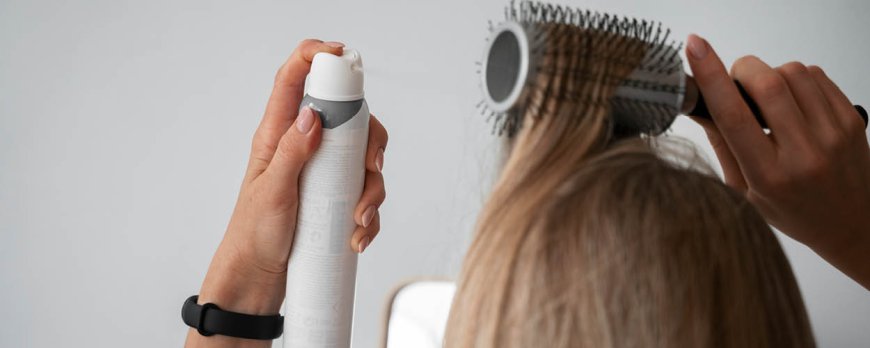Does hair grow slower as it gets longer?
Explore the intriguing question: 'Does hair grow slower as it gets longer?' Dive into science behind hair growth and tackle this popular myth.

Many people wonder if hair grows slower as it gets longer, but let's dive into the science behind hair growth to find out the truth. Key Takeaways:
- Hair growth rate does not slow down as hair gets longer.
- Factors like breakage and styling practices can affect the length of hair.
- Longer hair is more susceptible to breakage.
- Elastic bands used to tie back long hair can cause breakage.
- Styling practices, such as using heat tools, can also cause damage and breakage.
- Hair has a predetermined lifespan before it falls out naturally, typically around six to eight years.
- The rate of hair growth and eventual length is influenced by genetics and overall health.
Understanding the Hair Growth Cycle
Before we can determine if hair grows slower as it gets longer, it's important to understand the hair growth cycle and its different stages. The hair growth cycle consists of three main phases: anagen, catagen, and telogen.
- Anagen Phase: This is the active growth phase of the hair follicles. Hair cells rapidly divide, and the hair shaft pushes up through the scalp. The length of the anagen phase varies for each individual, typically lasting between two and seven years.
- Catagen Phase: This is a transitional phase where hair growth slows down. The hair follicles shrink, and the hair shaft detaches from the blood supply. This phase lasts for two to three weeks.
- Telogen Phase: This is the resting phase where the hair follicles are inactive. The old hair strand remains in the follicle while a new hair begins to form underneath it. The telogen phase lasts for about three to four months before the old hair sheds and a new hair takes its place.
The hair growth cycle is not synchronized for all hair follicles, meaning that different hairs are in different phases at any given time. This is why some hairs are actively growing while others are shedding.
The Impact of Breakage on Hair Length
Breakage can have a significant impact on hair length, especially as hair gets longer. Longer hair is more susceptible to breakage because the strands are older and have been exposed to more wear and tear. Styling practices like using heat tools and tight hairstyles can weaken the hair shaft, leading to breakage.
To minimize breakage and maintain hair length, it's important to handle hair with care. Avoid using excessive heat, and use heat protectant products when styling. Opt for loose hairstyles that don't put too much tension on the hair. When tying back hair, use soft hair ties or scrunchies instead of tight elastic bands.
By understanding the hair growth cycle and taking steps to minimize breakage, you can help support healthy hair growth and achieve your desired length.

Debunking the myth
Contrary to popular belief, there is no scientific evidence to suggest that hair growth slows down as it gets longer. Hair growth rate is not determined by hair length alone. Instead, various factors can affect the length and overall growth of hair.
One common factor that can hinder hair growth is breakage. Longer hair is more susceptible to breakage because it has more length to break off. Styling practices, such as using heat tools or tight hair ties, can weaken the hair strands and lead to breakage. This can give the false impression that hair growth is slower when, in fact, it is the breakage that is affecting the overall length.
Lists of styling practices and habits that may affect hair growth:
- Excessive heat styling
- Tight hairstyles and hair ties
- Chemical treatments like perming or relaxing
- Infrequent or harsh brushing
Lists of hair care tips to minimize breakage and promote hair growth:
- Avoid excessive heat styling and use heat protectants when necessary
- Use hair ties made of gentle materials like silk or satin
- Take breaks from chemical treatments and use protein-rich hair masks to strengthen the hair
- Use a wide-toothed comb or a brush with soft bristles to detangle the hair
It is also important to note that hair has a predetermined lifespan before it falls out naturally. This lifespan typically ranges from six to eight years. Factors like genetics and overall health play significant roles in influencing the rate of hair growth and the eventual length it can reach. While it is not accurate to say that hair growth slows down as it gets longer, taking care of your hair and adopting healthy hair care practices can help maintain its length and promote optimal growth.

Factors Affecting Hair Growth
Several factors can influence the rate at which hair grows, including genetics, overall health, and hair care practices. Understanding these factors can help individuals make informed choices on how to promote healthy hair growth.
Genetics
Genetics play a significant role in determining the rate at which hair grows. Each person has a unique genetic makeup that determines their hair growth potential. Some individuals naturally have faster-growing hair, while others may have slower-growing hair. It's important to note that genetics cannot be changed, but understanding this factor can help manage expectations regarding hair growth rate.
Overall Health
The overall health of an individual can also impact hair growth. Poor nutrition, stress, hormonal imbalances, and certain medical conditions can contribute to hair loss or stunted growth. Maintaining a balanced diet, managing stress levels, and addressing any underlying health issues can promote optimal hair growth.
Hair Care Practices
The way we care for our hair can significantly affect its growth rate. Using harsh chemicals, excessive heat styling, and tight hairstyles can lead to hair breakage and damage. It's essential to use gentle hair care products, avoid excessive heat, and give your hair regular breaks from styling to prevent breakage and promote healthier, longer hair.
- Avoid using heat tools excessively or at high temperatures.
- Use a wide-toothed comb or a brush with soft bristles to gently detangle hair.
- Protect your hair from environmental damage by wearing a hat or using a leave-in conditioner with UV protection.
- Trim the ends of your hair regularly to prevent split ends, which can lead to breakage.
- Avoid tight hairstyles that can pull on the hair follicles and cause breakage, such as tight ponytails or braids.
In conclusion, several factors can impact the rate at which hair grows, including genetics, overall health, and hair care practices. While hair growth does not slow down as it gets longer, it is essential to take care of your hair to prevent breakage and maintain healthy lengths. By understanding these factors and implementing proper hair care practices, individuals can promote optimal hair growth and achieve their desired hair length.

The Impact of Breakage on Hair Length
Breakage can play a significant role in the perceived growth rate of hair, especially as it gets longer. Longer hair is more vulnerable to breakage because it has more length to break off. When hair breaks, it may give the impression that the hair is not growing as quickly or as long as desired.
One common cause of breakage is the use of elastic bands to tie back long hair. These bands can cause stress and tension on the hair, leading to breakage. To minimize breakage, it is recommended to use hair-friendly alternatives like scrunchies or fabric hair ties that are gentle on the hair.
Styling practices that involve heat tools, such as flat irons or curling wands, can also contribute to breakage. The excessive heat can weaken the hair shaft, leading to breakage and split ends. It is important to use heat protectant products and avoid excessive heat exposure to maintain the integrity of the hair.
Overall, breakage can impact the perceived growth rate of hair. To mitigate breakage, it is important to handle the hair gently, avoid tight hairstyles that pull on the hair, and protect the hair from excessive heat and friction. By taking these steps, individuals can maintain the length and appearance of their hair while supporting healthy growth.
Styling practices and their effects on hair growth
Certain styling practices, such as using heat tools and tight hair ties, can negatively impact hair growth, especially as hair gets longer. Heat tools like flat irons and curling irons can cause damage to the hair shaft, leading to breakage and split ends. The excessive heat weakens the hair and strips it of its natural moisture, making it more prone to breakage.
When hair is tied tightly with elastic bands or hair ties, it can put excessive tension on the hair follicles. This can lead to traction alopecia, a condition characterized by hair loss due to constant pulling or tension on the hair. Traction alopecia is particularly common among individuals who frequently wear tight ponytails, buns, or braids.
To promote hair growth and maintain length, it is important to opt for gentler styling practices. Here are some tips:
- Avoid using heat tools excessively, and always use a heat protectant spray before styling.
- Opt for looser hairstyles that don't put excessive tension on the hair follicles.
- Use hair-friendly accessories like scrunchies or fabric hair ties that are less likely to cause breakage.
- Minimize the use of chemical treatments, such as perms or relaxers, which can weaken the hair.
- Regularly trim the ends of the hair to prevent split ends and breakage.
By adopting these practices, you can help protect your hair from damage and promote healthy growth, regardless of its length. Remember, while hair growth rate may be influenced by various factors, taking care of your hair and avoiding damaging styling practices are crucial for maintaining its length and overall health.

The Lifespan of Hair
Every hair on our head has a predetermined lifespan before it naturally falls out, which can affect the overall length and growth rate of hair. Understanding the lifespan of hair is key to understanding how our hair grows and changes over time.
The hair growth cycle consists of different stages: anagen, catagen, and telogen. During the anagen phase, which lasts around two to seven years, the hair actively grows. The length that hair can reach during this phase is determined by genetics and other factors. After the anagen phase, the hair enters the catagen phase, which is a transitional phase. This lasts for a few weeks and marks the end of active hair growth. Finally, the hair enters the telogen phase, which is a resting phase that lasts for about two to three months before the hair naturally falls out.
The Impact of Breakage on Hair Length
- Longer hair is more susceptible to breakage because it has more length to break off.
- Elastic bands used to tie back long hair can cause breakage, especially if they pull tightly on the hair.
When breakage occurs, it can give the illusion that hair is growing slower or not at all. To maintain hair length, it's important to take steps to prevent breakage, such as avoiding tight hairstyles and using gentle hair ties. Regular trimming of the ends can also help remove any split or damaged hair, promoting overall hair health.
Additionally, certain styling practices can have a negative effect on hair growth. Heat tools, like flat irons and curling irons, can cause damage and breakage, particularly if used frequently or at high temperatures. It's important to use heat protectant products and limit the use of heat tools to minimize damage to the hair. By adopting healthier hair care practices, we can help support the natural growth and length of our hair.
Genetics and hair growth
Genetics play a significant role in determining the rate at which hair grows and the eventual length it can reach. Each individual has a unique genetic makeup that influences various aspects of their hair, including its growth rate. Some people naturally have faster hair growth rates, while others may have slower rates. This genetic variation can explain why some individuals seem to have longer hair more easily than others.
In addition to the genetic factors that determine hair growth rate, genetics also play a role in the ultimate length that hair can reach. Some individuals have hair that naturally grows longer and has a longer lifespan before falling out, while others may have hair that reaches a certain length and then falls out more quickly. This genetic predisposition to hair length can help explain why some people struggle to grow their hair past a certain point, while others have no trouble achieving longer lengths.
Factors affecting hair growth
While genetics play a significant role in determining hair growth rate and length, it is important to note that other factors can also impact the overall health and appearance of hair. Factors such as overall health, diet, and hair care practices can all influence hair growth. Poor nutrition or certain medical conditions can lead to slower hair growth or hair loss. On the other hand, a balanced diet and a healthy lifestyle can promote optimal hair growth.
Additionally, the way we care for our hair can affect its growth and length. Excessive heat styling, frequent use of harsh chemicals, and tight hairstyles that cause tension on the hair can all contribute to breakage and damage, which can give the illusion of slower hair growth. Therefore, it is important to adopt hair care practices that promote healthy hair growth, such as using heat protectants, avoiding over-styling, and using gentle hair ties.
Conclusion
In conclusion, there is no scientific evidence to support the myth that hair grows slower as it gets longer. Factors such as genetics and hair care practices have a more significant impact on hair growth rate and length.
Factual data suggests that hair growth does not slow down as it gets longer. However, there are factors that can affect the length of hair, such as breakage and styling practices. Longer hair is more vulnerable to breakage because it has more length to break off.
Elastic bands used to tie back long hair can also cause breakage. Additionally, styling practices like using heat tools can cause damage and breakage, particularly at the ends of the hair. This can give the illusion that hair is growing slower.
Hair has a predetermined lifespan before it falls out, which is typically around six to eight years. The rate of hair growth and eventual length is influenced by factors like genetics and overall health. These factors play a more significant role in determining hair growth rate and length than the popular myth suggests.
FAQ
Does hair grow slower as it gets longer?
No, hair growth does not slow down as it gets longer. However, factors such as breakage and styling practices can affect the length of hair.
What factors can affect hair growth?
Genetics, overall health, and hair care practices can influence the rate of hair growth.
How does breakage impact hair length?
Longer hair is more susceptible to breakage, which can cause it to appear as though hair is growing slower. Preventing breakage is important to maintain hair length.
Can styling practices affect hair growth?
Yes, certain styling practices, such as using heat tools and tight hair ties, can cause damage and breakage, which can hinder hair growth.
What is the lifespan of hair?
Hair has a predetermined lifespan before it naturally falls out, typically around six to eight years.
How does genetics influence hair growth?
Genetics play a role in determining hair growth rate and length, leading to individual differences in hair growth.


































































































































